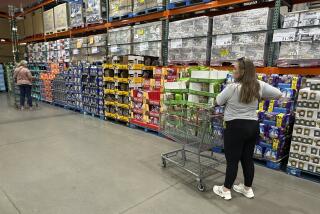Modest Gains in Personal Income, Spending in May
- Share via
WASHINGTON — Americans’ personal income and spending grew modestly in May, the government reported Friday, but economists said consumer spending likely will weaken this summer as wages lag behind inflation.
The Commerce Department said income rose 0.3% last month following a 0.1% gain in April.
Meanwhile, personal consumption expenditures, which include virtually everything except interest on debt, rose a moderate 0.5% in May following a 0.4% increase in April.
John Hagens, an economist with the WEFA Group, a Bala Cynwyd, Pa., consulting firm, described the spending increase as “sort of run of the mill,” translating into a real annual growth rate of about 2.5% after the 0.3% rise in consumer prices in May is taken into consideration.
“I think basically our biggest concern is how weak consumer spending is. . . . The income growth is simply not there to support much growth, particularly given higher food prices expected because of the drought,” he said. “I don’t think we’ll get 2.5% this summer.”
Effect of Tax Bite
Through the first five years of the six-year economic expansion, consumer buying has fueled the growth. Now, analysts are looking for exports and sale of equipment to businesses to drive the economy.
Americans’ disposable income--what they have left after paying taxes--shot up 1.5% in May, after a 1.0% drop in April that was the largest decline in a year.
That was the result of the big tax bite the government takes on April 15. Personal tax payments fell at an annual rate of $35.2 billion in May after rising $36.9 billion in April.
In all, personal incomes rose $13.3 billion to a seasonally adjusted annual level of $3.95 trillion.
The report said both the April and May increases look weaker because March income was boosted by profit-sharing payments to Ford Motor Co. workers and retroactive Social Security payments. Also, a lag in federal payments to farmers held back the May advance.
Excluding those special factors, the government said personal income would have advanced 0.8% in April and 0.4% in May.
Americans saved $151.9 billion in May, compared to $119.6 billion in April, boosting the personal savings rate to 4.5% from 3.6%.
The April savings rate was unusually low because of income tax payments. On average, Americans have been saving 4.4% of their income so far this year, compared to a rate of 3.7% last year.
Hagens said the rate could decline this summer as consumer dip into their savings to bolster purchasing power eroded by inflation. But he said that likely would be only temporary and cannot support consumer spending in the long run.
Wages and salaries rose at an annual rate of $12.2 billion in May after an $11.8-billion increase in April. Farm income fell $2.4 billion last month following an $11.9-billion drop in April.
On the spending side, purchases of durable goods, “big ticket” items expected to last three or more years, decreased $1.5 billion last month, following a $7.9-billion April increase. Purchases of non-durable goods rose $7.6 billion, following a $5.1-billion decrease.
Purchases of services, which includes housing costs, rose $9.6 billion, following a $10.8-billion increase.
More to Read
Inside the business of entertainment
The Wide Shot brings you news, analysis and insights on everything from streaming wars to production — and what it all means for the future.
You may occasionally receive promotional content from the Los Angeles Times.










